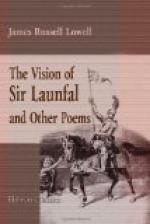THE CHANGELING
This is one of the tender little poems that refer to the death of the poet’s daughter Blanche, which occurred in March, 1847. The First Snow-fall and She Came and Went embody the same personal grief. When sending the former to his friend Sydney H. Gay for publication, he wrote: “May you never have the key which shall unlock the whole meaning of the poem to you.” Underwood, in his Biographical Sketch says that “friends of the poet, who were admitted to the study in the upper chamber, remember the pairs of baby shoes that hung over a picture-frame.” The volume in which this poem first appeared contained this dedication—“To the ever fresh and happy memory of our little Blanche this volume is reverently dedicated.”
A changeling, according to folk-lore and fairy tale, is a fairy child that the fairies substitute for a human child that they have stolen. The changeling was generally sickly, shrivelled and in every way repulsive. Here the poet reverses the superstition, substituting the angels for the mischievous fairies, who bring an angel child in place of the lost one. Whittier has a poem on the same theme, The Changeling.
29. Zingari: The Gypsies—suggested by “wandering angels” above—who wander about the earth, and also sometimes steal children, according to popular belief.
52. Bliss it: A rather violent use of the word, not recognized by the dictionaries, but nevertheless felicitous.
AN INDIAN-SUMMER REVERIE
Lowell’s love of Elmwood and its surroundings finds expression everywhere in his writings, both prose and verse, but nowhere in a more direct, personal manner than in this poem. He was not yet thirty when the poem was written, and Cambridge could still be called a “village,” but the familiar scenes already had their retrospective charms, which increased with the passing years. Later in life he again celebrated his affection for this home environment in Under the Willows.
“There are poetic lines and phrases in the poem,” says Scudder, “and more than all the veil of the season hangs tremulously over the whole, so that one is gently stirred by the poetic feeling of the rambling verses; yet, after all, the most enduring impression is of the young man himself in that still hour of his life, when he was conscious, not so much of a reform to which he must put his hand, as of the love of beauty, and of the vague melancholy which mingles with beauty in the soul of a susceptible poet. The river winding through the marshes, the distant sound of the ploughman, the near chatter of the chipmunk, the individual trees, each living its own life, the march of the seasons flinging lights and shadows over the broad scene, the pictures of human life associated with his own experience, the hurried, survey of his village years—all these pictures float before his vision; and then, with an abruptness which is like the choking of the singer’s voice with tears, there wells up the thought of the little life which held as in one precious drop the love and faith of his heart.”




